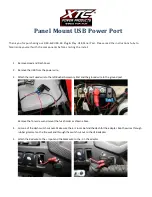
(2) Apply 50 mm (2 in.) masking tape in 150 mm
(6 in.) lengths along weatherstrips, weld seams or
moldings. After each length is applied, drive the vehi-
cle. If noise goes away after a piece of tape is applied,
remove tape, locate, and repair defect.
POSSIBLE CAUSE OF WIND NOISE
•
Moldings standing away from body surface can
catch wind and whistle.
•
Gaps in sealed areas behind overhanging body
flanges can cause wind-rushing sounds.
•
Misaligned movable components.
•
Missing or improperly installed plugs in pillars.
•
Weld burn through holes.
STANDARD PROCEDURE
STANDARD PROCEDURE - PLASTIC BODY
PANEL REPAIR
There are many different types of plastics used in
today’s automotive environment. We group plastics in
three different categories: Rigid, Semi-Rigid, and
Flexible. Any of these plastics may require the use of
an adhesion promoter for repair. These types of plas-
tic are used extensively on DaimlerChrysler Motors
vehicles. Always follow repair material manufactur-
er’s plastic identification and repair procedures.
Rigid Plastics:
Examples of rigid plastic use: Fascias, Hoods,
Doors, and other Body Panels, which include SMC,
ABS, and Polycarbonates.
Semi - Rigid Plastics:
Examples of semi-rigid plastic use: Interior Panels,
Under Hood Panels, and other Body Trim Panels.
Flexible Plastics:
Examples of flexible plastic use: Fascias, Body
Moldings, and upper and lower Fascia Covers.
Repair Procedure:
The repair procedure for all three categories of
plastics is basically the same. The one difference is
the material used for the repair. The materials must
be specific for each substrate, rigid repair material
for rigid plastic repair, semi-rigid repair material for
semi-rigid plastic repair and flexible repair material
for flexible plastic repair.
Adhesion Promoter / Surface Modifier:
Adhesion Promoters/Surface Modifiers are required
for certain plastics. All three categories may have
plastics that require the use of adhesion promoter/
surface modifiers. Always follow repair material man-
ufacturer’s
plastic
identification
and
repair
procedures.
SAFETY PRECAUTION AND WARNINGS
WARNING:
•
EYE PROTECTION SHOULD BE USED WHEN
SERVICING
COMPONENTS.
PERSONAL
INJURY
CAN RESULT.
•
USE AN OSHA APPROVED BREATHING MASK
WHEN MIXING EPOXY, GRINDING, AND SPRAYING
PAINT OR SOLVENTS IN A CONFINED AREA. PER-
SONAL INJURY CAN RESULT.
•
AVOID PROLONGED SKIN CONTACT WITH
RESIN, PETROLEUM, OR ALCOHOL BASED SOL-
VENTS. PERSONAL INJURY CAN RESULT.
•
DO NOT VENTURE UNDER A HOISTED VEHI-
CLE THAT IS NOT PROPERLY SUPPORTED ON
SAFETY
STANDS.
PERSONAL
INJURY
CAN
RESULT.
NOTE:
•
When holes must be drilled or cut in body pan-
els, verify locations of internal body components
and electrical wiring. Damage to vehicle can result.
•
Do not use abrasive chemicals or compounds
on undamaged painted surfaces around repair
areas. Damage to finish can result.
RIGID, SEMI-RIGID, AND FLEXIBLE PLASTIC PARTS TYPES
CODE
FAMILY NAME
COMMON TRADE NAME
TYPICAL APPLICATION
ASA
ACRYLONITRILE STYRENE
ACRYLITE
LURAN S
CONSOLES, GRILLES
ABS
ACRYLONITRILE BUTADI-
ENE STYRENE
TERLURAN
9
A” PILLARS, CONSOLES,
GRILLES
ABS/PC
ABS/PC ALLOY
PULSE, PROLOY, BAY-
BLEND
DOORS, INSTRUMENT PAN-
ELS
VA
BODY
23 - 3
Содержание SPRINTER2006
Страница 6: ......
Страница 44: ......
Страница 66: ......
Страница 96: ......
Страница 102: ......
Страница 110: ......
Страница 130: ...INDEX DESCRIPTION FIGURE 05 FRAME DIMEN SIONS 1 5 05 FRAME DIMEN SIONS 2 6 FRAME DIMENSIONS 7 13 4 FRAME BUMPERS VA ...
Страница 131: ...Fig 5 05 FRAME DIMENSIONS 1 VA FRAME BUMPERS 13 5 Ill 1316 92 II I 2991 92 4925 92 DATUM 81590161 ...
















































